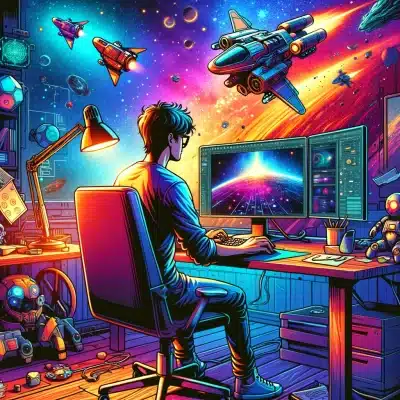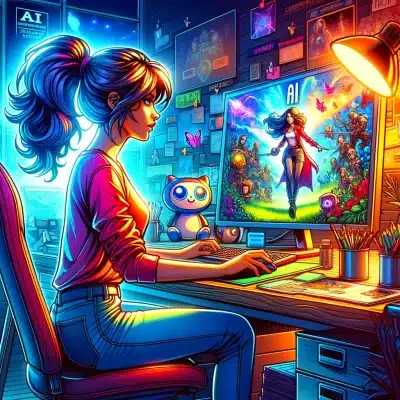In the rapidly evolving world of video games, the integration of artificial intelligence (AI) is not just a trend—it’s a revolution. “AI game development” is a term that’s increasingly capturing the imagination of developers and players alike, promising a future where games are more immersive, intelligent, and engaging than ever before.
This exploration into AI’s role in shaping the next generation of gaming is inspired by insights gathered from various experts in the field, reflecting on a groundbreaking YouTube presentation on the subject.
IMAGE: OPTICOUS
The Evolution of AI in Gaming
Gaming has always been on the frontier of technological innovation, with AI at the heart of the evolution. Initially, AI in games was rudimentary, controlling NPCs (Non-Player Characters) with simple behaviors. Today, AI game development is pioneering sophisticated simulations, procedural content generation, and dynamic storytelling, transforming how games are played and created.
AI’s Impact on Game Design and Development
The AI game development landscape is witnessing a seismic shift in how games are conceptualized, designed, and played. At the core of this transformation is AI game development’s capability to infuse games with intricate, dynamic worlds and characters that respond intelligently to player inputs.
Through procedural content generation, AI game development not only expedites the creation of expansive environments but also ensures that each gamer’s journey is distinct. This uniqueness boosts the game’s appeal, prompting players to return, thereby amplifying both replayability and player engagement.
Titles such as “No Man’s Sky” and “Minecraft” underscore the potential of AI game development in crafting limitless realms where discovery is perpetual. In these games, AI-generated landscapes and ecosystems challenge players, offering new encounters with every session.
Beyond environment creation, AI game development revolutionizes character behavior through AI-driven NPCs (Non-Player Characters). These entities exhibit learning capabilities, adjusting their actions based on the gamer’s strategies, thus delivering a nuanced, unpredictable gaming environment.
Such NPCs can evolve, making decisions that reflect their interactions and experiences with players, which adds a layer of depth and authenticity to the virtual world.
The integration of AI game development is not merely about technological advancement; it’s about redefining the essence of gaming itself. Through AI game development, developers can forge emotional connections, craft compelling narratives, and deliver experiences that resonate deeply with players.
As AI game development continues to mature, its role in game design and development will undoubtedly expand, promising a future where games are more lifelike, engaging, and tailored to individual player experiences. The journey of AI game development is on a trajectory to redefine gaming’s boundaries, making it an exciting time for both creators and gamers alike.
Revolutionizing Graphics and 3D Models with AI in Game Development
One of the most groundbreaking applications of AI in game development lies in the creation of graphics and 3D models. The advent of AI technologies has paved the way for remarkable advancements in this area, enabling developers to create more realistic, detailed, and dynamic visuals than ever before.
This section explores how AI is transforming the landscape of game visuals, from character design to environmental creation, and what this means for the future of gaming.
AI-Powered Graphics Generation
At the forefront of AI’s impact on game visuals is the concept of AI-powered graphics generation. Traditional methods of creating game graphics and 3D models are time-consuming and labor-intensive, involving manual design, texturing, and animation. However, AI can automate and enhance these processes, significantly reducing development time and allowing for more complex and nuanced designs.
Machine learning algorithms, for example, can analyze vast datasets of images and models to generate new graphics that meet specific criteria. This capability not only speeds up the creation process but also introduces a level of detail and realism previously unattainable. Games employing AI-generated graphics can offer unparalleled visual fidelity, drawing players into more immersive and believable worlds.
Dynamic 3D Model Adaptation
Another exciting development is AI’s role in dynamic 3D model adaptation. AI algorithms can modify and adapt 3D models in real-time, responding to game events or player actions. This dynamic adaptation can apply to character models, environmental elements, or even entire game levels, allowing for a highly responsive and evolving game world.
For instance, an AI system could adjust a character’s appearance based on in-game decisions, environmental conditions, or player preferences. This adaptability not only enhances the gaming experience but also opens up new avenues for storytelling and gameplay, where visual elements directly reflect the game’s evolving narrative.
Procedural Content Generation and Environmental Design
AI’s capabilities extend to procedural content generation (PCG), where algorithms create game content on the fly, based on a set of rules. This technique is particularly effective for environmental design, allowing AI to generate vast, complex, and varied game worlds automatically.
By employing AI in PCG, developers can create environments that are not only expansive but also rich in detail and diversity. This approach offers infinite possibilities for exploration and interaction, making each player’s experience unique. Furthermore, AI-driven environmental design can adapt to player actions, changing the game world in response to player choices and creating a dynamic, interactive ecosystem.
Enhancing Realism through AI
The quest for realism in video games is an ongoing pursuit, and AI is significantly contributing to this goal. Through advanced algorithms, AI can simulate realistic lighting, shadows, and physics, enhancing the visual authenticity of games. AI can also generate lifelike animations and behaviors for characters and creatures, making them move and react in ways that closely mimic real life.
The integration of AI in the creation of graphics and 3D models is not just about improving visuals but about enriching the overall gaming experience. By leveraging AI, developers can push the boundaries of what’s possible, creating games that are not only visually stunning but also deeply immersive and interactive.
The use of AI in generating graphics and 3D models represents a significant leap forward in game development. It enables the creation of more realistic, detailed, and dynamic visuals, which in turn enhances the player’s immersion and interaction within the game world.
As AI technology continues to evolve, its impact on game development is poised to grow, promising a future where games are not just played but experienced on a whole new level.
By embracing AI in the creation of graphics and 3D models, the gaming industry is setting a new standard for visual excellence and immersive gameplay. The future of AI game development holds incredible potential, and the journey into this uncharted territory is only just beginning.
The Role of AI in Player Experience
AI game development also extends to improving player experience through personalization and adaptive difficulty levels. AI can analyze a player’s behavior and preferences, tailoring the game experience to their skills and interests. This customization ensures that games remain challenging but not frustrating, keeping players engaged and motivated.
Furthermore, AI can create dynamic narratives where decisions genuinely affect the game’s outcome, leading to multiple storylines and endings. This not only enhances replay value but also gives players a sense of agency and immersion that was previously difficult to achieve.
The Future of AI Game Development
Looking ahead, the potential for AI in game development is boundless. Technologies like machine learning and neural networks are opening new avenues for creativity and innovation. AI is set to revolutionize game testing, with the ability to automatically detect and fix bugs, improving game quality and reducing development time.
Additionally, the integration of AI with other technologies, such as virtual reality (VR) and augmented reality (AR), promises to create even more immersive and interactive gaming experiences. The future of AI game development is not just about making games but redefining what games can be.
Challenges and Considerations
Despite its potential, AI game development comes with its challenges. Ethical considerations, such as the creation of highly realistic violence or the potential for AI to manipulate player behavior, must be addressed. Furthermore, the increasing complexity of AI systems necessitates skilled developers and significant resources, potentially limiting access to smaller studios.
Engaging with the AI Game Development Community
Diving into the AI game development community opens doors to a vibrant ecosystem of innovators and creators. Platforms such as GitHub not only serve as repositories for cutting-edge tools and libraries but also foster collaboration among developers passionate about pushing the boundaries of AI game development.
Game development forums provide a space for exchanging ideas, solving challenges, and sharing successes, helping both novices and veterans navigate the complexities of incorporating AI into games.
The Game Developers Conference (GDC) stands as a beacon for professionals seeking the latest trends, techniques, and insights in AI game development. It’s an annual gathering that showcases groundbreaking research, case studies, and panels led by industry leaders. Similarly,
Unity’s AI Blog is a goldmine of information, offering tutorials and articles that cover AI’s practical applications in game development. These resources not only educate but also inspire developers to explore new possibilities within AI game development.
Engagement with these communities and platforms is essential for anyone looking to make their mark in AI game development. Whether it’s through participating in discussions, attending conferences, or contributing to open-source projects, being active in the community accelerates learning and innovation.
It connects developers with peers and mentors who can provide support, feedback, and partnership opportunities, making the journey into AI game development a collaborative and enriching experience.
Conclusion
AI game development is at the forefront of a new era in gaming, offering endless possibilities for innovation, creativity, and engagement. As AI continues to evolve, so too will the worlds we create and explore in games. The journey of AI in gaming is just beginning, and for developers and players alike, the future is bright and full of potential.
By exploring AI game development, we not only anticipate the future of gaming but also contribute to its shaping. The interplay between technology and creativity in this field is a testament to the limitless possibilities that await those willing to venture into the unknown. The era of AI in gaming is here, and it promises to redefine our understanding of what games are and what they can become.
IMAGE: OPTICOUS
If you are interested in even more entertainment-related articles and information from us here at Notilizer, then we have a lot to choose from.


COMMENTS